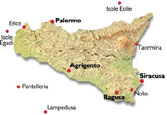 |
 |
|
Selinunte (TP) | ||
|
||||||||
|
"The marks of its ancient consequence are visible in the venerable ruins found in the neighbourhood." Lemprière's Classical Dictionary
The former Syracusan democratic leader, Hermocrates, now persona non grata at home, tried to re-establish Selinus, with himself as ruler in 408 BC - but was killed the next year attacking his native city. People drifted back, but Selinus never recovered her former splendour - she was to be part of the Carthaginian sector, until Carthage decided to abandon the site in 250 BC (the Romans were by now showing their ambitions in Sicily) - and the site has remained virtually deserted ever since.
The 1993 rains had washed out numerous fragments of red-figure pottery - it would have been easy to build up a collection. The temples are in two groups - the east group consists of Temples E, F and G. Temple E is the one that's been restored, and Temple G is the huge one to the north (second in size only to the Temple of Zeus in Agrigento) - large enough to envelop three Temple Fs. It was never finished - work was rudely interrupted by Hannibal in 409 BC - columns intended for it can still be seen half-hewn from the rock in the quarries of Cusa (Rocche di Cusa) 19 kilometres to the west. Of the western temples, the most obvious is Temple C - on the highest point of the Acropolis. It probably dates from the 6th century BC - and it's the one many of the larger metopes in Palermo came from; the smaller ones are from the obviously-named "Temple of the Small Metopes".
The site was being "tastefully" developed when I was there in 1993 - grassy ramparts had been added to screen Temples E, F and G from the car-park, and the new hotels being built at Marinella. Gaps provided "viewpoints" of the temples - and would presumably eventually enable the powers to charge for entry. On a wet day in November, I was the only visitor: I simply climbed over the embankment. A sunken road links the two parts of the site (I had to pay £2000 to enter the Acropolis), passing a track to the beach (which would be attractive in summer) - and picnic places curiously protected with notices warning about "rettili". (What sort of reptiles? Reminds me of a notice I once came across in a Surrey wood warning that "Corylus avellana abounds here with ordinary British snakes" - as any Classicist will know corylus is the hazel-tree! Sicily, like Britain, has no alarming reptiles.) Returning in 2007 I found the site totally fenced, and a single entry point established, where charges were indeed exacted.
|
 |
Use the table below to find your way around Sicily: |  |
||||||||||
| Map | Index | PA | ME | CT | EN | CL | SR | RG | AG | TP | ||
Printer friendly page: click to print
| What's new? | Search the site? | Main Index? | Bookshop? | Top of Page? | ||||
|
The Classics Pages are written and designed
by Comments, questions and contributions welcome. |
||||||||